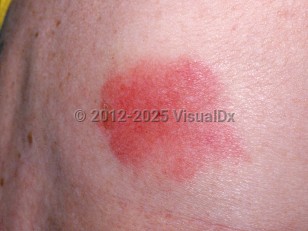Bumblebee sting in Adult
Alerts and Notices
Important News & Links
Synopsis

Bumblebees (genus Bombus) are found worldwide, typically in higher latitudes that range from warm to cold climates. Approximately 45 species exist in North America and about 160 species in other parts of the world.
They are relatives of the honeybees but are larger, much more hairy, and characterized by distinct yellow or white bands on their abdomen. Bumblebees are social bees that live in smaller colonies than honeybees. Most species are docile, but queen and worker bees will sting in self defense or when their nest is disturbed. Unlike the honeybee, the stinger is not barbed and does not get stuck in the skin. Therefore, bumblebees can sting more than once.
Bumblebee venom is similar to honeybee venom, and there is cross-reactivity. Bumblebee venom contains phospholipase A2, serine protease, hyaluronidase, acid phosphatase, and several allergens not found in honeybees.
Bumblebee anaphylaxis is rare compared to stings from wasps, hornets, and honeybees due to their docile nature. People at highest risk are those who are occupationally exposed to bumblebees, such as gardeners who use bumblebees for pollination, scientists, and bumblebee breeders. Some individuals are sensitized to bumblebee venom, while others are sensitized to honeybee venom and then develop an allergic reaction to a bumblebee sting due to cross-reactivity.
Local bumblebee sting reactions include immediate pain, swelling, and redness at the sting site that often subsides within a few hours.
Regional reactions (exaggerated local reactions) occur in some individuals with extended swelling that can last 2-7 days. These reactions are not allergic in origin.
Anaphylactic reactions cause diffuse urticaria, pruritus, angioedema, bronchoconstriction, respiratory distress, hypotension, loss of consciousness, and cardiac arrhythmias. Typically, anaphylactic signs occur within 10 minutes of the sting.
They are relatives of the honeybees but are larger, much more hairy, and characterized by distinct yellow or white bands on their abdomen. Bumblebees are social bees that live in smaller colonies than honeybees. Most species are docile, but queen and worker bees will sting in self defense or when their nest is disturbed. Unlike the honeybee, the stinger is not barbed and does not get stuck in the skin. Therefore, bumblebees can sting more than once.
Bumblebee venom is similar to honeybee venom, and there is cross-reactivity. Bumblebee venom contains phospholipase A2, serine protease, hyaluronidase, acid phosphatase, and several allergens not found in honeybees.
Bumblebee anaphylaxis is rare compared to stings from wasps, hornets, and honeybees due to their docile nature. People at highest risk are those who are occupationally exposed to bumblebees, such as gardeners who use bumblebees for pollination, scientists, and bumblebee breeders. Some individuals are sensitized to bumblebee venom, while others are sensitized to honeybee venom and then develop an allergic reaction to a bumblebee sting due to cross-reactivity.
Local bumblebee sting reactions include immediate pain, swelling, and redness at the sting site that often subsides within a few hours.
Regional reactions (exaggerated local reactions) occur in some individuals with extended swelling that can last 2-7 days. These reactions are not allergic in origin.
Anaphylactic reactions cause diffuse urticaria, pruritus, angioedema, bronchoconstriction, respiratory distress, hypotension, loss of consciousness, and cardiac arrhythmias. Typically, anaphylactic signs occur within 10 minutes of the sting.
Codes
ICD10CM:
T63.441A – Toxic effect of venom of bees, accidental, intial encounter
SNOMEDCT:
241820008 – Bee sting
T63.441A – Toxic effect of venom of bees, accidental, intial encounter
SNOMEDCT:
241820008 – Bee sting
Look For
Subscription Required
Diagnostic Pearls
Subscription Required
Differential Diagnosis & Pitfalls

To perform a comparison, select diagnoses from the classic differential
Subscription Required
Best Tests
Subscription Required
Management Pearls
Subscription Required
Therapy
Subscription Required
References
Subscription Required
Last Updated:02/20/2018
 Patient Information for Bumblebee sting in Adult
Patient Information for Bumblebee sting in Adult
Premium Feature
VisualDx Patient Handouts
Available in the Elite package
- Improve treatment compliance
- Reduce after-hours questions
- Increase patient engagement and satisfaction
- Written in clear, easy-to-understand language. No confusing jargon.
- Available in English and Spanish
- Print out or email directly to your patient
Upgrade Today

Bumblebee sting in Adult

